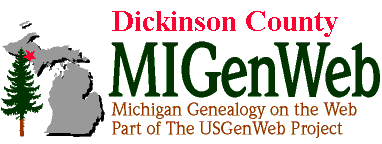Almanac
|
Founded: Set off from Marquette and Menominee Counties. Organized in 1891, Dickinson is the youngest county in Michigan. Dickinson County is located in the southwest portion of Michigan's Upper Peninsula at 46°00'N 87°52'W. The county is drained by the Menominee, Ford, and Escanaba Rivers. Bordering counties are Iron County, Marquette County, and Menominee County. Dickinson County is bounded on the southwest by Wisconsin. This is primarily a dairying and agricultural area raising cattle, potatoes, and hay ~ though there is still some lumbering. Most manufacturing is found at Iron Mountain. The region is viable tourist area with resorts, hunting, fishing, and winter sports. Dickinson is one of four Michigan counties in the central time zone. Its northern boundary and the northern part of its eastern boundary coincide with Central⁄Eastern time zones. Population Statistics
On 1 July 2002, Dickinson County ranked as the 52nd most populous county in Michigan.
And just FYI because... the average snowfall in Dickinson County is 60-110 inches.
The State of Michigan Michigan got its name from the Indian word "michi-gama," meaning "Great Lake." This state touches on all but one of the Great Lakes and has 40,000 square miles of water within its boundaries. Woodland Indians lived in the land when French explorers and fur traders first came to it. Once the timber, minerals, and fertile soil were discovered, settlers flocked to Michigan. They stayed to make this state first in production of automobiles, breakfast cereals, furniture, cherries, cucumbers, navy beans, and seedling pines. Michigan "Wolverine State"
A Brief Comment Regarding the Upper Peninsula The U.P. was settled far earlier than it would have been had mineral wealth not been discovered. This area was far removed from the nearest settlements. Its only link to “civilization” was the Great Lakes waterway which was completely cut off during the winter months. The isolation and mix of native and ethnic settlers created a region with a unique cultural heritage. It is amazing that the landscape of sculptured rocks and broken ridges described by early settlers over 100 years ago are still there. The vegetation has been changed substantially in some places, but these landmarks provide a wonderful aid to visualize how wilderness looked and felt to Michigan’s early pioneers. And more poignantly, to realize those places where whole towns of people lived and died are reclaimed by forests, with only overgrown cemeteries to stand as a reminder of their existence. The histories preserved in books serve as a reminder of how short life is and reminds us from whence we came. |
